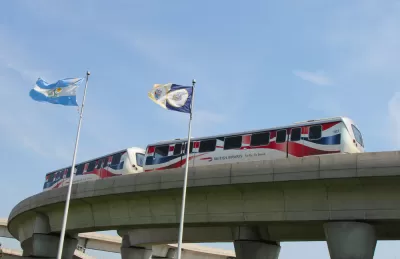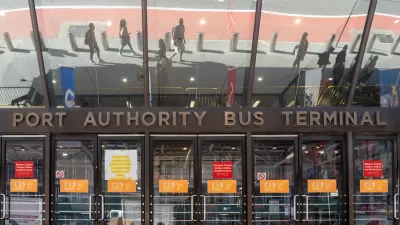Some inquisitive and interested observers noticed surprising changes to the schedule of the AirTrain, connecting Queens to JFK International Airport.

"By most accounts, the JFK AirTrain has been a success story." So goes the auspicious opening line of an article by Benjamin Kabak, which has found some numbers that cast doubt on the success story.
Kabak also acknowledges early on that the AirTRain served 2.5 million riders in its first year—a number that grew to 6.5 million ten years later in 2014. "But a funny thing happened on the way to 6.5 million riders: The Port Authority has quietly reduced the frequency of service on the AirTrain," writes Kabak.
In addition to the concern about reduced frequencies on such a popular service, Kabak expresses frustration with the lack of transparency regarding the reduced frequencies. On the former concern:
As recently as 2009, the Port Authority operated the JFK AirTrain on five-minute peak-hour headways and 10-minute off-peak headways. A recent brochure tells a much different story as peak headways are now 7-12 minutes with service operating every 10-15 minutes between 7:30 a.m. – 3 p.m. and every 15-20 minutes from 8 p.m. until 4 a.m. This is, effectively, a 50 percent service cut.
And on the latter frustration:
It’s not quite clear when these new timetables went into effect or why. The Port Authority hasn’t responded to requests for comment yet. But posts on an aviation-related message board indicate reduced AirTrain frequency as long ago as 2011. This isn’t a new problem, but it seems to be one the Port Authority has slipped past the public without much notice.
Kabak doesn't shy away from criticism of the Port Authority of New York and New Jersey, which runs the AirTrain, but his concern is that reduced service and crowded trains might indicate larger problems with the 12-year old system. Also, there's a LaGuardia AirTrain proposal, out of Governor Andrew Cuomo's office, still on the table and very much up for debate.
FULL STORY: A look at the decreasing frequency of the JFK AirTrain

Maui's Vacation Rental Debate Turns Ugly
Verbal attacks, misinformation campaigns and fistfights plague a high-stakes debate to convert thousands of vacation rentals into long-term housing.

Planetizen Federal Action Tracker
A weekly monitor of how Trump’s orders and actions are impacting planners and planning in America.

San Francisco Suspends Traffic Calming Amidst Record Deaths
Citing “a challenging fiscal landscape,” the city will cease the program on the heels of 42 traffic deaths, including 24 pedestrians.

Defunct Pittsburgh Power Plant to Become Residential Tower
A decommissioned steam heat plant will be redeveloped into almost 100 affordable housing units.

Trump Prompts Restructuring of Transportation Research Board in “Unprecedented Overreach”
The TRB has eliminated more than half of its committees including those focused on climate, equity, and cities.

Amtrak Rolls Out New Orleans to Alabama “Mardi Gras” Train
The new service will operate morning and evening departures between Mobile and New Orleans.
Urban Design for Planners 1: Software Tools
This six-course series explores essential urban design concepts using open source software and equips planners with the tools they need to participate fully in the urban design process.
Planning for Universal Design
Learn the tools for implementing Universal Design in planning regulations.
Heyer Gruel & Associates PA
JM Goldson LLC
Custer County Colorado
City of Camden Redevelopment Agency
City of Astoria
Transportation Research & Education Center (TREC) at Portland State University
Jefferson Parish Government
Camden Redevelopment Agency
City of Claremont




























